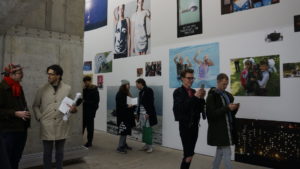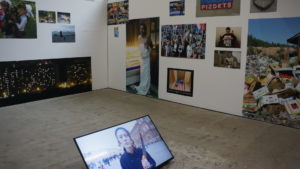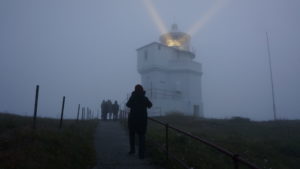Оn the Possibility of Light
In the Chto Delat Collective’s 2014 exhibition, Time Capsule: In a Moment of Danger, we were searching for a visual language capable of reflecting our state of shock at a moment when the foundations of our work—together with social and personal relations and our belief in the possibilities of politics and art—began to collapse before our eyes. The situation might have been described as extreme, critical, or exceptional, and gradually became the norm for our everyday existence. Our activities were forced to reflect the rapid narrowing of the public sphere, the constantly increasing marginalization of the ideas we value, the departure of close associates, the loss of any way of distinguishing fact from fiction (post-truth), and the disappearance of friendly institutions and core funding structures for our work. If earlier, the concept of the crisis situation as a norm through political history had always been present in our analyses, it now began to control our entire lives, wielding its own absurd sovereignty.
Nowadays, having since adapted to this new condition, we perceive the situation through the despairing lens of Ukrainian artist Nikita Kadan: “What was on the extreme right has crept into the enlightened center…And what was on the extreme left crumbled into the outer darkness, where there is weeping and gnashing of teeth. The Left, the diehard post-Soviet Left, famished materialists, anemic educators, fine-boned humanists. How is it beyond the fringe? How is the darkness? Can you make out each other’s figures? Is it too late to be afraid?” (1)
Earlier, this may have sounded like a diagnosis of the Russo-Ukrainian state of affairs, wherein we perceived an exceptional or excluded position—we see now that the condition has crept and spread throughout the world, so that you can no longer discern which country the Facebook post you are reading is from: Might it be from England, Hungary, Poland, Egypt, Israel, Turkey, or the United States?
***
The situation in Russia remains unique because of the low level of resistance, calling to mind Bertolt Brecht’s gloomy remark in the poem To Posterity (1939), where he writes of “despairing / When there was only injustice and no resistance.” But even here (in Russia) the question is not yet settled, however, and many scenarios have yet to play out, and we still have the chance to speak, to find like-minded people and to struggle together as we have throughout all these years, full of exciting creative work, obsessive energy, inspirations, and hopes. The darkness—which, following Christian tradition, has always been a major subject on the Left—has not yet closed in. Rather, we are living through a prolonged twilight of reaction, a period of global transformation.
Some speak of the collapse of the humanist project, others of the menace of the dark Enlightenment, a return to the Middle Ages. Many have no firm grasp on anything other than a general feeling of disorientation, depression and powerlessness. But it is important to acknowledge this condition: not as the latest outburst of a moribund conservatism familiar to us from history, but as the scenario of a different kind of universal global condition where the ideas and values on whose behalf we long ago decided to fight are not provided for—they are simply not needed. In their place, ideas of progress and contemporaneity have been put forward which no longer require equality and justice. The Enlightenment tradition has once again been revealed to be fragile and abandoned, in need of new reinterpretation and defense.
***Perhaps this threat will force us to reconsider many things and band together with renewed vigor?
After all, we have nowhere to flee: there is no place left where the old Enlightenment consensus is not in jeopardy. The challenge of encroaching darkness must be taken up.
This can be done mystically, as Giorgio Agamben proposes: “Is darkness not an anonymous experience that is by definition impenetrable; something that is not directed at us and thus cannot concern us? On the contrary, the contemporary is the person who perceives the darkness of his time as something that concerns him, as something that never ceases to engage him. Darkness is something that—more than any light—turns directly and singularly toward him. The contemporary is the one whose eyes are struck by the beam of darkness that comes from his own time.” (2)
Or we can turn to Hannah Arendt and her re-reading of the tale of Danko(3): “Even in the darkest of times we have the right to expect some illumination, and that such illumination may come less from theories and concepts than from the uncertain, flickering, and often weak light that some men and women, in their lives and works, will kindle under almost all circumstances and shed over the time-span that was given them on earth.” (4)
Or, as Leonard Сohen sang: “There is a crack in everything / That’s how the light gets in.” (5)
Light—you never know where it comes from.
To become more poriferous. To drink some phosphorus. To produce more holes, cracks, and lighthouses.
January 2017
Footnotes:
1) *The text reflects recent discussions and publications, and the author would like to express gratitude to those who participated: Mikhail Kurtov for his text “Рассеянность, растерянность, пористость: три режима эстетического” (Absentmindedness, Confusion, and Porousness: Three Regimes of the Aesthetic), the collective behind the journal Просторы (Expanses) for our discussion of darkness, and Taus Makhacheva for her poetic observations.
From Nikita Kadan’s text “Зерна” (Sees) , published on the internet in the journal Просторы (2017), http://prostory.net.ua/ua/avtorski-rozdily/sections/32-zerna/64-zerna.
2) From Giorgio Agamben’s article “What is the Contemporary?” in What is an Apparatus? and Other Essays, trans. David Kishik and Stefan Pedatella (Palo Alto, CA: Stanford University Press, 2009), 45.
3) A tale written by Maxim Gorky (Danko’s Burning Heart, 1895) about a hero who, in order to light the way out of slavery for his people, tore out his heart, which shined like a flame.
4) From Hannah Arendt’s book Men in Dark Times (New York, Harcourt, Brace & World, 1968), xi.
5) From Leonard Cohen’s song “Anthem,” on the album The Future (Columbia Records, 1992).









 – Memorials to Weak Light
– Memorials to Weak Light  – Performative Practices of Our Time
– Performative Practices of Our Time – Dream of a Protester
– Dream of a Protester  – It Hasn’t Happened With Us Yet.
– It Hasn’t Happened With Us Yet.
